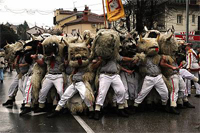The United Nations on Wednesday declared seven cultural elements of Croatia a world cultural treasure adding it to the UNESCO's heritage list.
In all, 76 cultural elements were inscribed on the UNESCO Representative List of the Intangible Cultural Heritage of Humanity, chosen by 400 experts from the 24 Member States of the Intergovernmental Committee for the Safeguarding of the Intangible Heritage at its fourth session in Abu Dhabi, United Arab Emirates.
Following are the elements from Croatia which were inscribed on the list yesterday:
- Annual carnival bell ringers' pageant from the Kastav area - During the January carnival period, bell ringers march through the villages that dot the Kastav region in north-west Croatia. Clothed in sheepskin throws with bells around their waists and sporting distinctive hats embellished with sprigs of evergreen, two to more than thirty ringers swagger in groups behind a guide carrying a small evergreen tree.
- The festivity of Saint Blaise, the patron of Dubrovnik - The evening before the festivity of Saint Blaise in Dubrovnik, Croatia, as all the church bells in the city ring and white doves are released as symbols of peace, worshippers gather for a ritual healing of the throat to preserve them against illness. On the third of February, the official day of both saint and city, parish banner bearers flow into the city in folk costume for the centrepiece of the festival, a procession attended by bishops, ambassadors, civic leaders, visiting notables and the people of Dubrovnik.
- Lacemaking in Croatia - At least three distinct traditions of Lacemaking in Croatia persist today, centred on the towns of Pag on the Adriatic, Lepoglava in northern Croatia and Hvar on the Dalmatian island of the same name.
- Procession Za Krizen ('following the cross') on the island of Hvar - After mass on Maundy Thursday before the Christian holiday of Easter, each of six villages on the Dalmatian island of Hvar in southern Croatia sends out a group that will proceed through the other villages in a circle, covering twenty-five kilometres in eight hours before returning home. Each party in this community-organized Za Krizen ('following the cross') procession is led by a cross-bearer who walks barefoot or in socks, never resting.
- Spring procession of Ljelje/Kraljice (queens) from Gorjani - The Procession of Queens is performed by the young girls of the village of Gorjani in the Slavonia region of north-east Croatia every spring.
- Traditional manufacturing of children's wooden toys in Hrvatsko Zagorje - Villagers along the pilgrimage route to the Marian shrine of Our Lady of the Snow in Marija Bistrica in Hrvatsko Zagorje in northern Croatia developed a technique for traditional manufacturing of children's wooden toys that has now been handed down for generations. The men in a family take soft willow, lime, beech and maple wood from the region and dry, hew, cut and carve it using traditional tools; the women then apply ecologically-friendly paint in improvisational floral or geometric patterns, painting 'from imagination'.
- Two-part singing and playing in the Istrian scale - On the Istrian peninsula in western Croatia, several varieties of two-part singing and playing in the Istrian scale are preserved by Croatian, Istro-Romanian and Italian communities. The style is characterized by vigorous, partly nasal singing.
 The Paris-based UNESCO decided in 2001 to offer the same protection to living traditions as to natural and cultural treasures such as the Great Wall of China or the Great Barrier Reef, with 90 customs added so far to its list.
The Paris-based UNESCO decided in 2001 to offer the same protection to living traditions as to natural and cultural treasures such as the Great Wall of China or the Great Barrier Reef, with 90 customs added so far to its list.
Yesterday’s inscriptions ranged from Latin America's tango culture to religious ceremonies, like the Procession of the Holy Blood in Bruges, Belgium, the Panagyr ritual on the feast days of Saints Constantine and Helena in Bulgari, Bulgaria, and religious ritual theatre in the Garhwal Himalayas, India, to lace making in Cyprus, a masked end-of-winter carnival in Mohács, Hungary, and the Voladores ('flying men') fertility dance of ethnic groups in Mexico and Central America.
Image 1: Lacemaking in Croatia
Image 2: Annual carnival bell ringers' pageant from the Kastav area
© Ministry of Culture Croatia